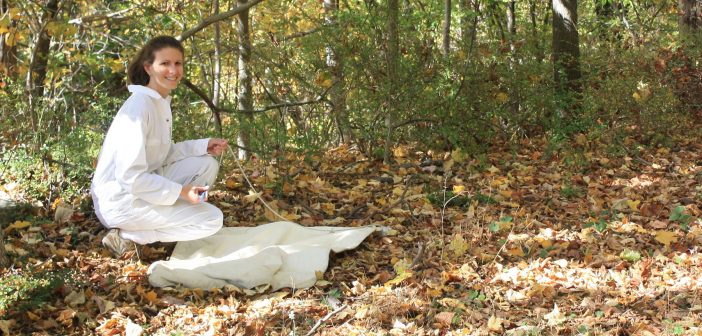The result of a new study at Fordham’s Calder Biological Field Station is challenging a traditionally accepted scientific hypothesis on biodiversity and Lyme disease.
The hypothesis, known as the “dilution effect”, says that disease pathogens are less frequent in areas with a greater number of host species.
“Some hosts are really bad at maintaining and transmitting the Lyme disease pathogen, and some are very good, what we call competent reservoirs,” said Christine Zolnik, PhD, a recent doctoral graduate and co-author of the study recently published in PLoS ONE. “The thinking is that the more species you have, then the more you’re able to dilute what we call the ‘competent reservoir.’”
Computer Simulation vs. Hard Numbers
Blacklegged ticks are known to transmit Lyme disease to a variety of animals. They have more than 100 potential host species, and in the past 10 to 15 years the Lyme/tick/host relationship has become an oft-cited example of the dilution effect.
Many of the studies on dilution effect are built on computer simulations with limited empirical data—i.e.—hard numbers from the real world, said Zolnik. But for her study, she chose to compare actual areas.
“Because there’s such large number of potential tick hosts at a site, it’s very difficult to assess biodiversity at each collection location,” she said. “Therefore, I used habitat fragmentation as a proxy for biodiversity.”
The area of less biodiversity was one with “landscape fragmentation,” meaning lots of buildings and streets interrupting nature. The area of more biodiversity consisted of woodlands that provide uninterrupted food and shelter for a variety of creatures.
The thinking was that pathogen prevalence within a blacklegged tick population would vary greatly between a fragmented landscape and a less-fragmented landscape.
Fragmented Bronx Landscapes vs. the Woods of Westchester
Zolnik collected tick samples at 14 sites across the Bronx, Westchester, and Putnam counties in New York, and in Litchfield County, Connecticut.
The Bronx sites were far more fragmented than the other sites, but, to Zolnik’s surprise, fragmentation didn’t affect the number of infected ticks found.
“I did find variation between the sites, but I didn’t find any evidence to the dilution effect,” she said. “So we still really don’t have a handle on what’s influencing the infection rate.”
“This study provides evidence that is not in support of a hypothesis that is taken as dogma in the Lyme disease field,” she said. “Just because something is accepted doesn’t always make it correct. But this opens the door for other studies.”
Zolnik said that there’s plenty more to be studied, such as the composition of the host community beyond the well-known dominant species and reservoirs. She said that this is just the type of work that’s ongoing at Fordham’s Vector Ecology Lab where she began her dissertation work with advisors Thomas J. Daniels, PhD, the director of the Calder Center and Sergios-Orestis Kolokotronis, PhD, of the Biological Sciences department. Daniels, Kolokotronis and Richard Falco, PhD, of the New York State Department of Health co-authored the study.
Zolnik said that she didn’t set out to prove or disprove the hypothesis in her dissertation.
“I wanted to find evidence that either supported the hypothesis or not,” she said. “There was a gap in the literature that needed to be filled.”



